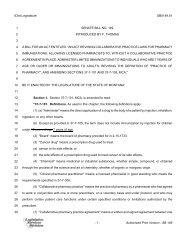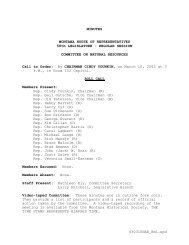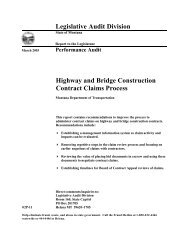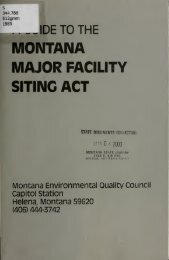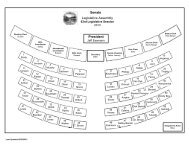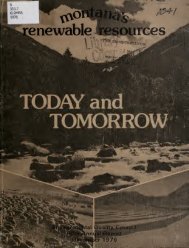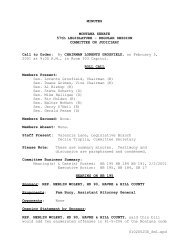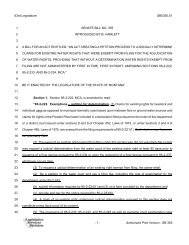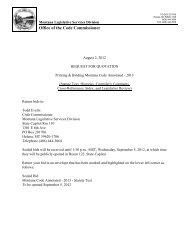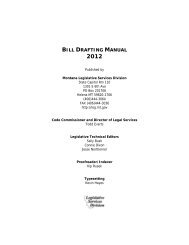Public Comment. Volume III - Montana Legislature
Public Comment. Volume III - Montana Legislature
Public Comment. Volume III - Montana Legislature
You also want an ePaper? Increase the reach of your titles
YUMPU automatically turns print PDFs into web optimized ePapers that Google loves.
Miles City Fish Hatchery<br />
Impact Analysis Studies and Proposed Mitigation<br />
Approach<br />
1.0 Introduction<br />
<strong>Montana</strong> Fish, Wildlife and Parks (MT DFWP) has drafted this impact analyses study<br />
description and proposed mitigation approach to create a clear, step by step impact<br />
evaluation and mitigation process that will be required for Tongue River Railroad<br />
Company (TRRC) to obtain an easement to cross the Miles City Fish Hatchery (MCFH).<br />
The impact analyses studies consist of pre-construction baseline studies to aid in<br />
.. accurately measuring MCFH production success, vibration and additional studies to<br />
determine the potential for impacts due to TRRC operations, and a mitigation plan for<br />
identifying and responding to losses attributable to TRRC construction and/or operation.<br />
MT DFWP has included information on current levels of production, fiscal value of the<br />
hatchery in terms of its contribution to the state's fish and recreation resources, and<br />
annual budget estimates to allow accurate valuation of potentiaI Iosses. All direct and<br />
indirect costs for implementing this mitigation plan, including all aspects fiom the two<br />
pre-construction studies to any actual repairs or replacement of hatchery products (e.g.<br />
eggs or fish) or facilities, will be TRRC's responsibility. MT DFWP will not bear<br />
responsibility for any increase in operating costs due to any activities associated with data<br />
gathering or execution of any mitigation activities. Should any costs of this nature occur,<br />
they will be reimbursable by TRRC. The mitigation plan shall be as quantifiableand<br />
clear as possible in order to avoid future negotiations that would delay mitigation for such<br />
a time sensitive resource.<br />
1.1 History<br />
MCFH was transferred to MT DFWP fiom the U.S. Fish and Wildlife Service in 1983<br />
for use as a warm-water fish production hatchery to meet the state's needs for game fish<br />
such as walleye, pike, bass, channel catfish, and various forage species. MCFH also<br />
provides rearing capacity for research species, species of special concern, and endangered<br />
species as needs arise within the state and surrounding region. MCFH's importance to the<br />
state's recreational fishery cannot be overemphasized as it is the sole source for warmwater<br />
game fish for 65 reservoirs, and provides cool and cold water fish for an additional<br />
67 reservoirs in <strong>Montana</strong>. The mean economical value to the state for the Fort Peck<br />
Reservoir alone in 1997 dollars was approximately $2,60 1,096, based on 36,309 angler<br />
days (G. Bertellotti, MT DFWP, personal communication, 1999). The economic value<br />
generated by the hatchery extends to the communities surrounding these reservoirs in the<br />
form of jobs and tourism.<br />
-222- <strong>Volume</strong> Ill: <strong>Public</strong> <strong>Comment</strong>



